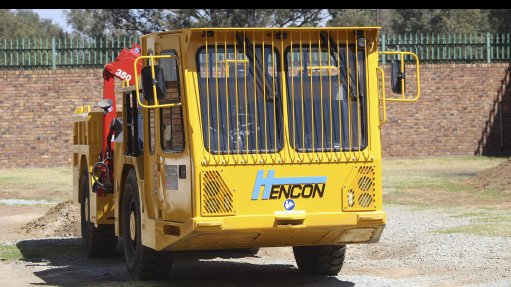
SAMSS dual lift utility vehicle
Photo by: Kutlwano Matlala
Metals industry equipment and service company South African Mining and Smelting Solutions (SAMSS) on Thursday launched its range of underground mining utility vehicles in the South African market.
At the launch event, SAMSS, which is a subsidiary of multinational foundry industry equipment manufacturer Dango and Dienenthal, showcased an underground tanker and a dual-lift vehicle at its factory in Ekurhuleni.
Dango and Dienenthal Southern Africa CEO Hannes Goosen said the company had tested the vehicles over four years in Russia, where they were designed, built and tested by SAMSS technical director JP van der Linde.
Goosen added that SAMSS’s vehicles had already met local mining safety standards, including roll-over protection, falling objects protection, automatic stop in the event of a loss of hydraulic pressure and emergency stop systems, such as if the vehicle loses power while on an incline.
The company would introduce the complete range of the SAMSS Transvers underground vehicles, which includes personnel transport, vacuum, mixers and explosives transport vehicles, to the South African market.
Additionally, SAMSS is designing low-profile versions of these vehicles.
The company also provides services and support throughout Africa through the Dango and Dienenthal and partners network.
The SAMSS vehicles are made by Dango and Dienenthal aluminium and mining equipment subsidiary Hencon in Russia and the Netherlands.
SAMSS hoped to gain sufficient orders from the African mining market to establish a factory in South Africa to produce the vehicles, said Goosen.
Van der Linde detailed some of the technical features of the vehicles, including that they use hydrostatic drive systems, meaning that there are no gears, gearboxes or drive shafts. This design means that the vehicles have very high availability, measured at between 90% and 95% during the trials in Russia.
Each vehicle’s Deutz diesel engine drives a hydraulic pump and hydraulic motor in a closed-loop system for each of the two drive shafts. The vehicles can navigate slopes up to 20° and water up to 1 m deep.
“This design makes the vehicle very fuel efficient, even when subjected to changes in speed, in contrast to conventional hydrodynamic drive mining vehicles.
“Additionally, this removes the problem of disproportionate wear on the lower gears of hydrodynamic drive mining vehicles,” he explained.
Properly maintaining the hydraulic fluid filters and ensuring oils were clean would allow the vehicles to operate effectively for many years, he emphasised.
The vehicles were available in left- or right-hand-drive formats, said Goosen.
The company has secured 90 orders internationally and it aims to complete the design of the low-profile vehicles within the next year.
“The global shift to electric vehicles should spur the development of new mines in Africa, and the expansion of existing mines. This is the market we aim to serve, and we also expect to gain orders from local mines owing to the quality, performance and reliability of these vehicles,” he said.